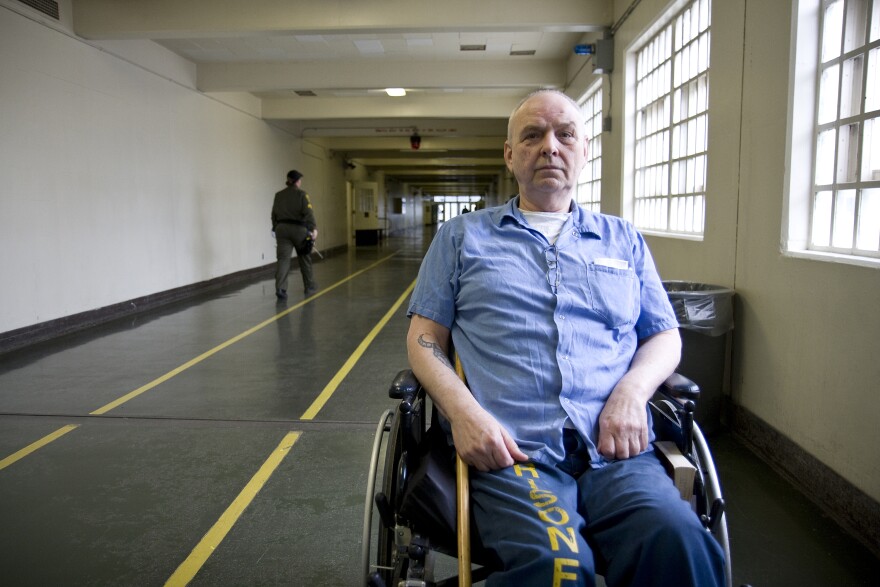SPECIAL SERIES
DWANE BROWN: As part of KPBS' special coverage of life in California prisons, KPBS sent a team of journalists to the California Medical Facility at Vacaville. Producer Angela Carone went along to photograph life in the state's largest prison hospital. Her photographs are now on view on kpbs.org. Angela, what were you hoping to capture with your camera?
ANGELA CARONE: The first thing you're struck by is how the California Medical Facility both looks like and doesn't look like a prison. There are guards, cells, and prison jumpsuits, but there are also men in wheelchairs, and others using walkers and canes. The population is much older than what you'd expect when you think of a prison and, of course, in the actual medical unit and hospice, the prisoners are quite sick. As the photographer on this story, I wanted to capture how CMF looks like what you expect a prison to look like and how it doesn't. I wanted to show the unexpected – in this case the elderly and medically infirmed -- in the midst of more traditional images of prison life.
BROWN: The California Medical Facility has a 17-bed hospice unit and you spent some time there photographing a prisoner named Brian Long. Tell us about him.
CARONE: Brian Long is 51 years old and he's dying of prostate cancer. I learned about him from one of the inmates who works in what is called pastoral services, which is an inmate volunteer program that provides comfort and care to dying inmates, things like sitting vigil when someone is close to death. He took me into Brian Long's room, and I noticed a couple of things right away. Long had clearly gone through chemotherapy and he looked like he was dying. He was extremely thin and pale, his eyes were hollow and he appeared much older than 51.
BROWN: How did you go about photographing him and trying to capture his experience?
CARONE: When I went into Long's room, he was writing a letter to his sister and I asked him if I could photograph while he wrote. He agreed. I knew I wanted to take his portrait, because his face really conveys how close he is to death. But I also wanted to document the way the room was decorated, and you can see this in one of my photographs. There's an effort in the prison hospice to humanize the rooms. There are shutters over the barred windows. There are pictures and posters on the walls, and he was covered by a quilt donated to the hospice.
Did Brian Long talk about the kind of care he is getting in the hospice unit?
CARONE: He did. He said the care is great and how grateful he is for it. He told me he has three months to live and he's applied for compassionate release, which if granted means that his sentence would be shortened or he would be released on parole to live out the remaining three months on the outside. But compassionate release is not often granted. In 2009, there were 57 applicants for compassionate release and only three were granted.
BROWN: You photographed a number of prisoners. Was it hard not to pass judgment.
CARONE: Well of course you enter these things with intending all objectivity. Helping me in that regard was that I didn't ask anyone about why they were in jail until after I photographed them for the captions. And in Long's case I didn't know until much later, and I'm glad I didn't know. I was photographing him in a very vulnerable state and I needed to proceed without any judgment. I needed to establish a connection with Brian Long for the exchange between photographer and subject.
After I returned to San Diego, I learned that in 1993, Long was convicted of having sex with a minor and served six years. In 2003 he was sentenced to 11 years for a second sexual offense against a child. And that does impact the way I look at those images now, but I still see, first and foremost, a man who is dying.
BROWN: Is there an image that really stands out for you as representative of what you saw that day?
CARONE: I'm not sure if there's one image but the image that surprised me most is one of an inmate in the medical unit sleeping on a cot. I had to shoot it through a small window in the door because we weren't allowed in the room. At the time, I was frustrated that we couldn't get access inside the room. But once I got home and looked at what I got, I'm so glad I had to shoot it the way I did. It added a lot of drama because you have this feeling that you're seeing something you shouldn't be seeing. And inside there is this sick man curled up in a fetal position on the bed in this stark room. It made it a more powerful image.






















